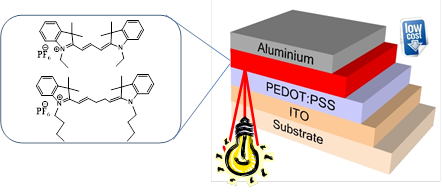- Universitat de València
- Bolink, Hendrik Jan
- PDI-Catedratic/a d'Universitat
- Tordera Salvador, Daniel
- PDI-Titular d'Universitat
- Vicedega/Vicedegana / Vicedirector/a Ets
- Responsables de Gestio Academica
- Coordinador/a Practiques Ext Centre
- Antonio Pertegas Ojeda
Generally, organic light-emitting diodes (OLEDs) have considerable advantages compared to other solid-state lighting technologies. Today best OLEDs use a multi-layer architecture that is very sensitive to ambient atmosphere. They are prepared using sequential evaporation in high vacuum chambers and need to be rigorously encapsulated. Light-emitting electrochemical cells (LECs) are much simpler, can be solution processed and are less sensitive to the ambient atmosphere. They use as electroluminescent material either a blend of a neutral semiconductor -usually a conjugated polymer- with a salt, or an ionic transition metal complex, possibly with the addition of a salt. The first system is difficult to prepare as the compatibility with the neutral semiconductor and the salt is poor, which lead to phase separation and unstable devices. The second one does not suffer from compatibility issues as the semiconductor is intrinsically ionic, yet it requires transition metals (usually Iridium, Ruthenium, Osmium, etc) which are very expensive starting materials.
Researchers from Universitat de València have developed a new type of LEC that use ionic organic dyes as the electroluminescent material. The use of ionic dyes leads to materials that do not suffer from compatibility issues and allows for a much more economic production of LECs. These dyes are known for many years and used in applications such as photographic films and recordable DVD discs, and are produced in large quantities at low cost. Some examples of suitable ionic organic dyes are cyanine, hemicyanine and squarilene dyes.
Researchers have found that these small ionic molecules are able to perform all necessary actions in LEC’s electroluminescent materials: transport of electrons, transport of holes and emission of photons. Therefore, it is not necessary to combine the dye with other charge transport material, simplifying and reducing the cost of the device.
LECs are interesting candidates for use in thin-film lighting applications, as they operate at very low voltages (yielding high power efficient devices) and are easy to produce. LECs can also be used for displays, as switching speed is comparable or even faster than with e-ink based displays.
The new types of LECs have the following advantages:
- Low cost: manufacture with commercial and readily available materials
- Performance: satisfactory radiance, efficiency and lifetime levels of the device, suitable for future technological applications.
- Solution processable from benign solvents.
- Patent granted
Blasco Ibáñez Campus
C/ Amadeu de Savoia, 4
46010 València (València)













